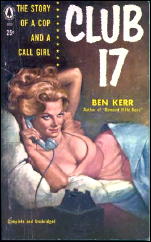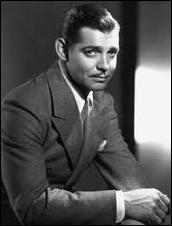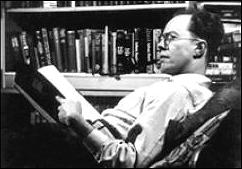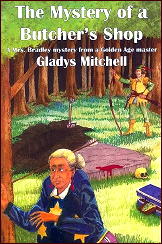Sun 12 Dec 2010
Mike Nevins on WILLIAM ARD, FRED DANNAY, ANTHONY BOUCHER and GLADYS MITCHELL.
Posted by Steve under Authors , Columns[10] Comments
by Francis M. Nevins

Something unusual happened to me on Thanksgiving morning and I’m thankful that it did. Browsing the Web for something entirely different (and apparently nowhere to be found), I stumbled upon a truly excellent website devoted to that unjustly forgotten Fifties hardboiled author William Ard, who managed to write something like three dozen novels before dying of cancer at age 37. With permission from website proprietor Dennis Miller, I hereby offer a link.
Decades ago, when I was writing the essays about Ard for The Armchair Detective that earlier this year I reorganized into a chapter for my book Cornucopia of Crime, I had had some correspondence and phone conversations with his widow and son.
Mrs. Ard, nee Eileen Kovara, was tremendously helpful, even loaning me her copy of one Ard novel I had never been able to locate on my own and have never seen since.

I learned from Dennis Miller’s website that both had died since I was last in touch with them, but he and I began emailing and I soon had the cyber-address of Ard’s daughter and got in touch with her.
Her father died destitute, she told me, and her mother had a hard time of it for many years, trying to support herself and two children on a secretary’s salary.
I now know a lot more about the Ard estate than I knew before Thanksgiving, and I’m hoping to persuade a publisher I know who loves hardboiled and noir novels from the Fifties to reissue a few of Ard’s, especially Hell Is a City (1955) and Club 17 (1957, as by Ben Kerr). As they say in the news biz, more details later.
In my last column I described how Fred Dannay, reprinting Dashiell Hammett’s first Continental Op story in EQMM decades after its first publication in 1922, tried to make it seem less like a period piece by inflating all the cash amounts and substituting common or garden variety bonds for the original version’s Liberty bonds, which the U.S. had sold to finance its entry into World War I.

This seems to have been a recurring editorial habit of Fred’s, and not even Ellery Queen stories were exempt from its reach. In EQMM for March 1959 he reprinted “Long Shot,†a Queen short story first published twenty years earlier, but changed the names of most of the movie stars who attend the big horse race.
Joan Crawford and Greta Garbo are fused into Sophia Loren, Al Jolson is replaced by Bob Hope, Bob Burns by Rock Hudson, Joan Crawford the second time by Marilyn Monroe, and Carole Lombard by Jayne Mansfield.
The only star who appears in both versions of the story is Clark Gable.
If I hang onto life and health long enough, one of the books I’d love to do is a volume of The Wit and Wisdom of Anthony Boucher.

Here’s a prime candidate for inclusion, from a letter of his to Manfred B. Lee of the Ellery Queen partnership, dated February 9, 1951.
As the Forties segued into the Fifties and network radio fell before the juggernaut of television, Boucher tried for months and perhaps years to establish a foothold in the new medium comparable to what he’d enjoyed in the middle and late Forties when he made hundreds of dollars a week (huge money in those days) providing plot synopses for Manny to expand into Queen radio scripts.
He got nowhere, but his frustration led to a memorable one-liner. “TV is to radio as radio is to films as films are to theater as theater is to publishing as publishing is to rational behavior.â€
Boucher once remarked that readers either love Gladys Mitchell or can’t stand her. I haven’t read enough of her dozens of novels to identify myself with either camp, but recently I tackled her second, The Mystery of a Butcher’s Shop (1930).

Perhaps a better title would have been one Harry Stephen Keeler used a few years later, The Riddle of the Traveling Skull (1934), since much of the plot concerns a dead man’s sconce that keeps disappearing and reappearing in different places.
Mitchell’s sleuth, the spectacularly ugly Mrs. Lestrange Bradley, is a professional psychoanalyst who, like her forerunner Philo Vance, eschews physical clues and favors those stemming from the psychology of the murderer.
For some unaccountable reason the excellent sketch of the crime scene isn’t printed until page 305, so that no reader could know it was there when it might have been helpful. At the center of events is an old Druid sacrificial altar surrounded by a perfect circle of tall pine trees. “There it crouched, a loathsome toad-like thing, larger than ever in the semi-darkness.â€
Add Mitchell to the toad-haters of the world! I wonder why Mrs. Bradley, who’s often described as looking like a crocodile or a pterodactyl, is never compared to that sweet-singing and useful amphibian known to biology as bufo bufo.
December 12th, 2010 at 8:17 pm
It’s a very nice map though! And Mrs. Bradley’s case notes at the end are quite interesting!
December 12th, 2010 at 8:57 pm
Curt
It was the Mrs. Bradley novel that caught your eye in Mike’s column, and I am not surprised.
To me Gladys Mitchell is an unknown quantity as an author. I started one of her books and never finished it, as I recall. I don’t remember the book as bad, just that at the time it didn’t catch my interest.
What did catch my attention was the first author Mike talked about, William Ard, and the good news that some of his work may be reprinted.
I would like it even more if there were some unpublished manuscripts, but I will take reprints of his work any day of the week.
I’ve recently begun to catalogue my collection, beginning with the A’s of course, and so far I’m into the into the B’s.
To my surprise, When I came to Ard, there are some of his books (mysteries) that I do not have. I’ll have to remedy that, posthaste.
Ard was one of the authors I discovered when I was 15 or so. Most of his books I found at local drugstores, once I’d started growing away from comic books, and I remember them well.
— Steve
December 12th, 2010 at 9:27 pm
At the first Milwaukee Bouchercon, both Richard Moore and I heard Mike give a talk about HELL IS A CITY. We were so inspired that we both rushed out and found copies of the novel. Neither one of us was as impressed with the book as we were with Mike’s talk about it. I see that I have a copy of CLUB 17. Maybe I should give that one a try.
December 12th, 2010 at 9:39 pm
I think Mike could make the lowliest Beacon paperback sound appealing, if he had a mind to. I don’t remember HELL IS A CITY myself, so I can’t say yea or nay on that one, but like Gold Medal paperbacks of the same era, to a 15-year-old, Ard’s books were racy and exciting — and maybe because of the covers, even grittier than the Gold Medals.
It’s been a long while since I was 15, though, and other than one or two of Ard’s westerns, I may not have read any since then.
Those were the days.
December 12th, 2010 at 10:11 pm
Steve, I suppose I’m always going to hone in on the British element in any article!
Mitchell really is a writer who provokes extreme reactions.
December 13th, 2010 at 5:57 am
I’ve been collecting Gladys Mitchell books on/off for some years now, and I must admit that I’ve become very fond of her stuff. She’s not a conventionally exciting writer, and she doesn’t rise to the plotting skill of a Carr or Christie, but there is something about her writing that keeps bringing me back. Her obsession with the bizarre and offbeat is one attraction, but she was also skilled at evoking a particular sort of mood that can’t easily be described. I would also say that in THE RISING OF THE MOON, she was able to capture a child’s tone of voice better than any other writer, and certainly without the sentimentality that can creep into the writing of, say, Ray Bradbury.
December 14th, 2010 at 7:55 am
My recall is similar to Bill’s – Mike’s talk about Ard (as with so many other writers he’s covered over the years) was a lot more entertaining than reading the Ard book in question.
December 14th, 2010 at 10:53 am
I second the motion on the British element.
One of my favorite quotes from Gladys Mitchell: “I very much like John Dickson Carr as a person, but can’t read his books.” Tough words! And ironic considering that in my talks with other mystery readers I find they love Carr and his wacky farcical plots and outrageous dialogue but cannot read any of Mitchell’s books. I think this is an almost inhernet American bias, though. Her style is as Bill Pronzini once said “veddy British.” But I have proudly made it through a handful of her books from start to finish (a few I have abandoned midstream) and I found MERLIN’S FURLONG to be the most entertaining and the breeziest read. A few of her early books require quite a bit of work to get through – for me at least. And many of her later books are just plain dull. DEATH OF A MAIDEN is supposedly quintessential Mitchell (for plot, style and atmosphere combined) and while I do recall that I enjoyed much of its sinister mood and the odd allusions to dryads and English folklore, I cannot remember a single thing about the story now.
December 14th, 2010 at 11:03 am
Oops… mistaking my mythological creatures in Mitchell’s DEATH OF A MAIDEN. Dryad is wrong – that’s a forest nymph. I meant of course a naiad – the river spirit. Spare me your wagging fingers, please.
December 14th, 2010 at 2:49 pm
I like Gladys Mitchell’s earlier books a great deal. They are more like true detective fiction and they are fantastically imaginative (too much so for a lot of people). I’ve never understood how Innes maintained a following in the U.S. and Gladys Mitchell not so much. Mitchell’s Butcher Shop is not really more bizarre than The Daffodil Affair or From London Far, for example.
I like both Carr and Mitchell and their work seems to me to have some points in common (though Carr’s puzzles are better).
Some Mitchell gets so convoluted I can’t appreciate it (I’m not sure even Mitchell knew what was going on). And I do agree much of the later Mitchell is dull, though there are some high points. I particularly like the two books about children: The much-praised The Rising of the Moon and the very late Late, Late in the Evening.
Funny how Keeler is very American and Mitchell very British but often they are both very weird. Butcher’s Shop seems to me like a Keeler book crossed with Dorothy L. Sayers or Margery Allingham or Ngaio Marsh.